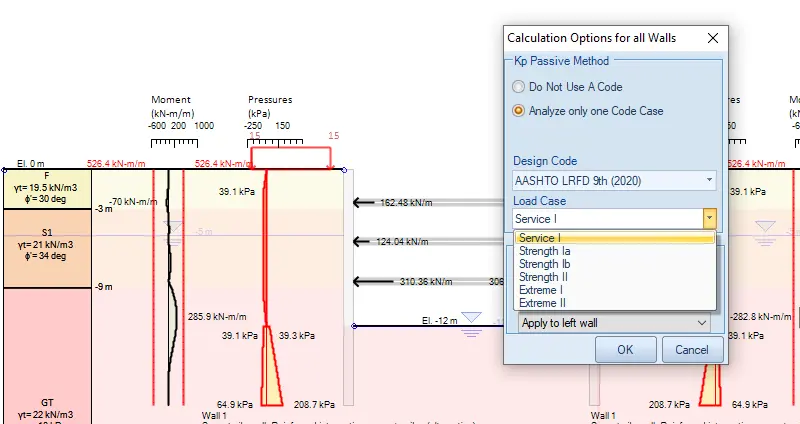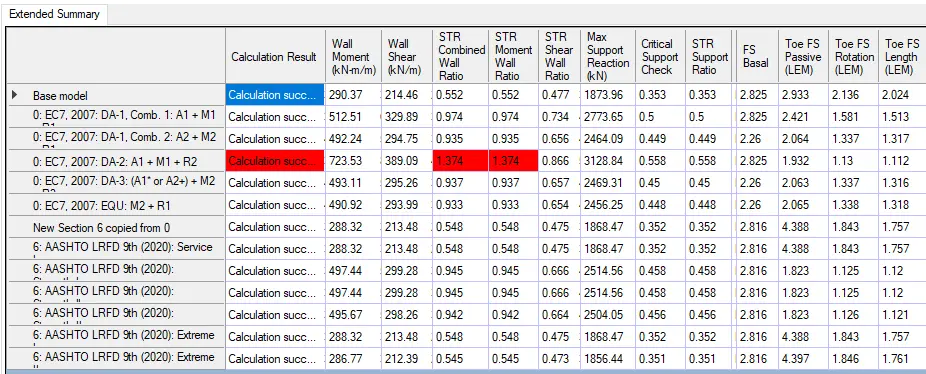Comparing Eurocode 7 and AASHTO LRFD in Geotechnical Design
- deepexcavation
- Jun 23
- 4 min read
A Practical Perspective Using DeepEX
Introduction
In geotechnical and structural engineering, code compliance is more than a checkbox—it defines the safety philosophy, performance expectations, and reliability targets of the entire project. Two widely used standards in this space are Eurocode 7 (EN 1997) and the AASHTO LRFD Bridge Design Specifications. Each is the cornerstone of geotechnical design in their respective regions—Europe and the United States—and reflects unique approaches to reliability-based engineering.
In today's interconnected design landscape, many projects span borders or are subject to international scrutiny. As such, engineers increasingly need tools that support multi-code compliance and comparative design workflows. To meet this demand, DeepEX – Shoring and Tunnel Design Software has integrated not only Eurocode 7 and AASHTO LRFD, but also other major standards such as the Canadian, Chinese codes, Indian IS standards, Australian AS codes, CALTRANS specifications, and more.
This article explores and compares Eurocode 7 and AASHTO LRFD from a geotechnical design standpoint, discussing their design philosophies, advantages, limitations, and how they are implemented in DeepEX. We will conclude with a real-world comparative case study involving a deep excavation with internal bracing analyzed under both standards.

Figure 1: 12 meters deep excavation with internal bracing – LEM analysis with DeepEX
Understanding the Standards
Eurocode 7 – EN 1997: Geotechnical Design
Eurocode 7 is the European standard for geotechnical design and part of the broader Eurocode suite. It embraces a limit state design (LSD) philosophy with a strong foundation in probabilistic and semi-probabilistic principles. The code introduces:
Two main limit states: Ultimate Limit States (ULS) for safety, and Serviceability Limit States (SLS) for usability.
Three Design Approaches (DA1, DA2, DA3), each prescribing different combinations of partial factors on actions (loads), material properties, and resistances.
Emphasis on site-specific ground investigations, advanced soil modeling, and realistic interpretation of ground behavior.
Advantages:
Encourages tailored, site-specific designs.
Offers flexibility through national annexes to reflect local practices.
Rigorous separation of geotechnical failure modes.
Limitations:
Complexity due to multiple design approaches.
National annex flexibility can lead to inconsistencies across regions.
Requires significant geotechnical input and expertise.

Figure 2: Eurocode 7 load combinations in DeepEX
AASHTO LRFD: Load and Resistance Factor Design
The AASHTO LRFD Bridge Design Specifications govern transportation infrastructure in the U.S. and emphasize a uniform, reliability-based approach to bridge design. In geotechnical design, it incorporates:
Multiple limit states: Strength, Service, Extreme Event, and Fatigue.
Use of calibrated load and resistance factors, derived from statistical reliability methods.
A more prescriptive framework, making it accessible for engineers with varying levels of geotechnical background.
Advantages:
Streamlined and standardized, especially for bridge and transportation infrastructure.
Clearly defined load combinations and design procedures.
Widely supported and implemented in U.S. public works.
Limitations:
Less flexible for site-specific adjustments.
Empirical methods dominate in some geotechnical components.
Can be conservative when conditions are well known.

Figure 3: AASHTO LRFD 9th load combinations in DeepEX
Comparing the Design Approaches
Aspect | Eurocode 7 | AASHTO LRFD |
Design Basis | Partial factor method with multiple design approaches (DA1–3) | Load and resistance factor design (single framework) |
Limit States | ULS and SLS | Strength, Service, Fatigue, Extreme Event |
Factorization | Separate factors for actions, resistances, material properties | Global load and resistance factors applied to nominal values |
Flexibility | High – adaptable via national annexes | Moderate – strong standardization |
Geotechnical Emphasis | Strong – dedicated geotechnical code | Moderate – embedded within structural bridge code |
Site Investigation | Highly emphasized and integrated | Required but allows use of conservative defaults |
User Complexity | Higher learning curve; requires engineering judgment | Easier adoption for general use |
Eurocode 7 and AASHTO LRFD in DeepEX
With both codes integrated, DeepEX allows engineers to run parallel analyses of the same excavation under Eurocode 7 and AASHTO LRFD. This includes:
Service and ultimate condition analysis for both codes.
Automatic generation of code-specific load combinations.
Handling of partial/resistance factors for different limit states and materials.
Visualization and comparison of results including moments, displacements, and support reactions.
This multi-code environment enables engineers to validate designs, optimize solutions, and tailor outputs for different regulatory authorities.
Case Study: 12-Meter Deep Excavation with Internal Bracing
To illustrate the practical differences between Eurocode 7 and AASHTO LRFD, we modeled a 12-meter deep excavation supported by internal struts, analyzed under both service and ultimate limit states.
Project Setup:
Retaining wall: Steel sheet pile
Support system: Internal bracing (3 levels of struts)
Soil profile: Stratified sandy clay layers with a high water table
Wall modeled with realistic wall-soil interaction using nonlinear springs
Analyzed Parameters:
Bending moments and shear forces along the wall
Maximum wall displacements under service conditions
Support reactions at each strut level
Wall embedment depth required to maintain FS = 1.0 against basal heave or toe failure
Sensitivity to water pressures and surcharge loading

Figure 5: DeepEX results – Eurocode 7: DA1 – Combination 2

Figure 6: DeepEX results – AASHTO LRFD 9th – Combination Strength 1a

Figure 7: DeepEX Results Summary Table – Critical Results for each load combination
Preliminary Findings:
Eurocode 7 (particularly DA2) produced higher bending moments and embedment depths, driven by its strict application of partial resistance factors.
AASHTO LRFD resulted in higher strut forces under strength limit states due to more aggressive load combinations.
Displacements were more closely controlled under EC7’s SLS requirements, though AASHTO LRFD’s service limit state still provided conservative guidance.
Variations in design outputs between codes reached 10–20% for certain parameters, reaffirming the importance of code-specific design.
Conclusion
Both Eurocode 7 and AASHTO LRFD are robust, reliability-based frameworks that serve the same ultimate purpose: to ensure safe, durable, and efficient geotechnical structures. However, they reflect different engineering cultures and expectations:
Eurocode 7 is ideal for customized, site-specific design with a higher emphasis on geotechnical rigor and serviceability.
AASHTO LRFD offers a streamlined, prescriptive approach that excels in standardized infrastructure like bridges.
With both codes integrated into DeepEX, engineers no longer have to choose one path. They can simulate, compare, and document multiple code-based designs in a single model, helping to improve quality, reduce risk, and meet international requirements—all in one powerful platform.
For engineers working globally, designing with confidence means designing with flexibility—and that’s what DeepEX delivers.
Let us show you how to reduce your design time by up to 90%!





